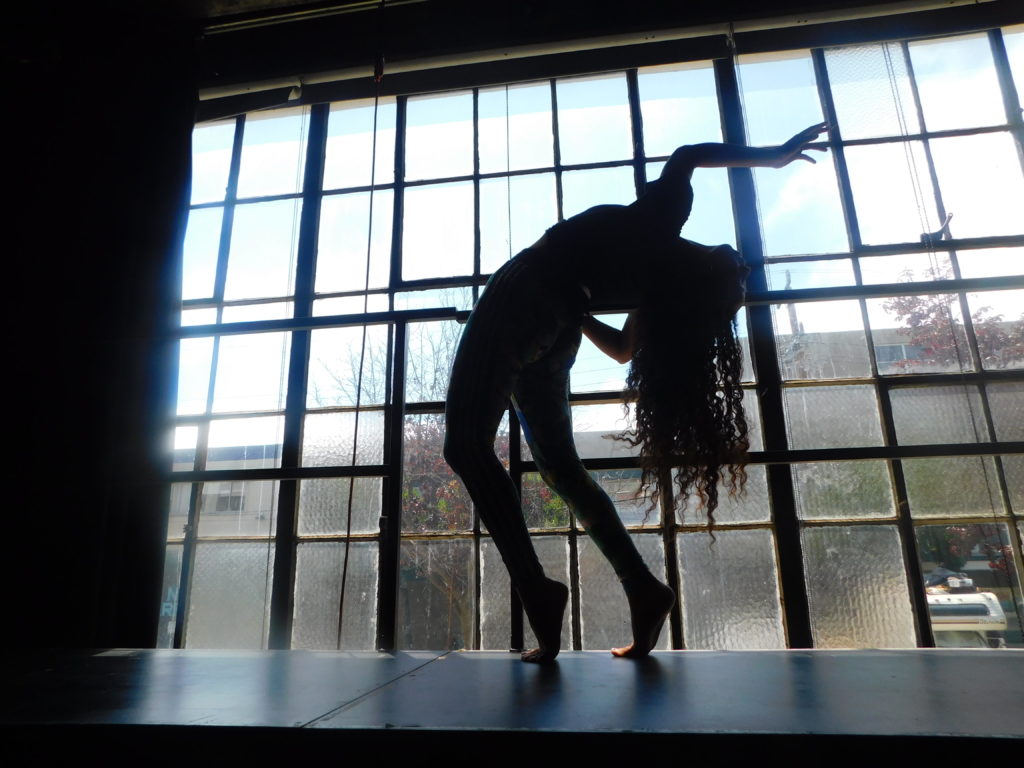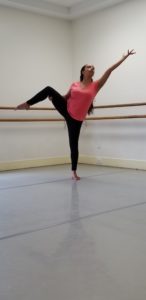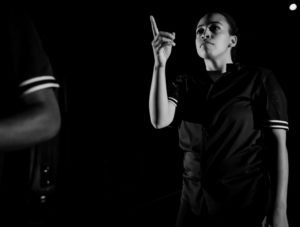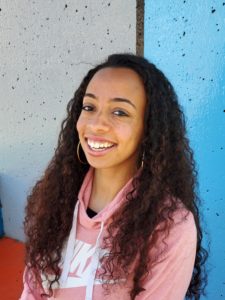
Whenever someone asks me to identify or define Jazz dance, I never have an easy answer. The Jazz dance tree is very dense: between Classic Jazz, Broadway Jazz, Contemporary Jazz, Urban Jazz, Jazz Funk, Afro-Jazz, Latin Jazz, Commercial Jazz, Street Jazz, and Lyrical Jazz, I can see why we’ve lost some of the history that inspired these sub-genres of Jazz. And while folks seem to recognize several characteristics of the style, they only scratch the surface of an African American dance form that serves as the foundation of popular styles like Funk, Disco, Hip-Hop, and Breakdance. Because the dances of so many music videos and halftime shows are rooted in Jazz, it has become hard to see the vernacular, social dance roots of the form. I’ve been inspired to reconnect with the roots of Jazz and learn more about its diverse history by embedding it throughout my dance career as a professional artist and educator.
Lindsay Guarino and Wendy Oliver’s book, Jazz Dance: A History of the Roots and Branches, sits on my bedside table, and I recently watched the documentary Uprooted: The Journey of Jazz directed by Khadifa Wong. These two sources confirmed the feeling I had leaving college, that Jazz is so much more than the commercialized version we see on mainstream media. There’s a rich history made up of a long list of trailblazers and dance legends that goes beyond Bob Fosse, Jack Cole, Gus Giordano, and Luigi to include names like Katherine Dunham, Pearl Primus, Pepsi Bethel, and Frank Hatchett, among many others. Many dancers today can name the first four artists, and either have never heard of or associate some of the latter four with modern dance forms. I challenge dance educators, instructors, studio owners, and dancers themselves to dig deeper and spend time learning the history of their dance movement, including the early dance legends who provided the roots and platform for what we celebrate in dance today.
Jazz is rooted in African American culture with origins traced back to the end of slavery and the beginning years of “freedom” for the Black community. The rise of Jazz music inspired a social dance r/evolution that makes up a lot of what we see in popular dance styles and trends today. Early dances like the Cakewalk and the Pattin’ Juba that led to Tap and Ballroom spin-offs like the Swing and Charleston showcase the connection and influence of Jazz music, its style, rhythm, and improvisation. The Savoy Ballroom in New York was a popular destination for Jazz musicians and dancers to show off their skills and keep up with the latest moves and sounds. The Lindy Hop, Jive, and Shimmy were dance styles that emerged from the Savoy’s dance community between the 1920s and 1940s. The musicians were inspired by Swing and Blues, call and response, improvisation, and polyrhythms in their compositions, which you can see reflected in the dancing of that time. This connection between Jazz dance and Jazz music is something I wish to see more of in the dance spaces I’ve occupied since childhood.

My story with Jazz started when my local dance studio, Adrienne’s Dance Studio, announced they would be offering a Jazz class for my age group. As an 8-year-old I was so excited to learn this new style that was always the most exciting to watch at our recitals: set to pop music and featuring strong lines, multiple pirouettes, high kicks, big leaps, sassy faces, and the fabulous “kick-ball-change jazz square.” I took Jazz all the way through high school, performing showstopping routines on competition teams throughout my teens. At this point, Jazz was my favorite dance style, but I had no historical knowledge of its roots or basic information about its legacy. And I definitely didn’t have the vocabulary to articulate any of the forms’ deeper meanings. I was mostly focused on mastering my technique to perform the “tricks” that were celebrated at competitions and local performances.
When I got to UC Irvine, I quickly discovered that I was just one of many students who were the top dancers at their home studios. We spent the first quarter comparing our split leaps, fouette turns, and illusions—a competition jazz turn where the dancer dives their head to the floor while shooting their leg to the sky—while dancing to Lady Gaga, Britney Spears, and whomever else was playing on the radio. But during my second quarter, we got a new Jazz professor, Dr. Sheron Wray. Dr. Wray single-handedly shifted the vibe, curriculum, and essence of Jazz in our department. She came in with a very codified technique (part of the Matt Mattox curriculum); played only Jazz music; celebrated African-American vernacular dance movement vocabulary (movements I’d seen my mom doing at family house parties); and gave us structured improvisation prompts in every single class. I felt like the few dancers of color and I collectively exhaled upon learning her style. After three years learning Jazz under Dr. Wray’s direction, I had completely changed my relationship to, knowledge of, and love for Jazz dance.

When I graduated from college, I walked away with a love for Jazz music, its expressive range and “aesthetic of cool,” a deeper appreciation for improvisation, and a balance of playfulness, release, contraction, dynamics, rhythm, theatrics, and stretch that inspires my practice today. There’s a magic to the early roots of Jazz that I would love to see in more classes and performances throughout the Bay Area and beyond. When I look around the Bay Area dance scene, there’s a short list of studios that offer Jazz[1] and if they do, it’s usually Contemporary based at prominent studios and Hip-Hop based in underground studios. Where can we find “Early Jazz,” Jazz taught with the early fundamentals of the dance form as a base? I look to Bay Area Dance leaders such as Antoine Hunter and Reginald Savage, who have preserved Jazz by creating dance companies centered around the form. I would love to see this list grow, celebrating Early Jazz, from the music to the freestyle jam sessions, to the community filled with heart-warming vibes right here in the Bay Area. Jazz deserves to be just as popular as Ballet, Modern, and Hip-Hop, especially since it incorporates all three styles seamlessly, which is what I try to highlight within my teaching practice.
As a dance teacher, I have recently held myself accountable to how I curate and lead the intentions of my classes. I’ve been teaching Jazz ever since I left college, but around four years ago, I decided I no longer wanted to teach Studio/Competition Jazz based classes. If I want to educate dancers about Jazz, I need to create the space for the Early Jazz experience to transpire within my classes. I decided to research the art form as deeply as I could, from reading books, to engaging in discussions with community members, to finding grainy videos from the early 1900s on YouTube. What I gathered is that Jazz is truly an experience and I cannot effectively teach it until I immerse students in the Jazz sensibility.
I started with creating a Jazz-only playlist; all the music I play, from warm-up to across the floor to final combination, is Jazz-based, spanning decades and styles from Blues Jazz and Afro Jazz to Latin Jazz and Funk Jazz. Some of the artists on my playlist are legends like Herbie Hancock, John Coltrane, Stevie Wonder, and Nina Simone; others are independent and emerging artists I find on Spotify from countries all around the world. There’s a great list of artists in “Neo-Jazz,” which gives a fresh outlook on what Jazz music can offer.

In terms of my pedagogy, I started using improvisation as a way to teach concepts in class, like playfulness with your dynamics, incorporating Jazz movement into your personal style, connecting with different rhythms in the music while in motion, and helping dancers find an expressive movement style to build upon. I also began introducing different ways to connect and respond to the music, exploring polyrhythms by initiating movement patterns based on the track. Once the pandemic hit, I started incorporating groove-based movements into my warm-ups and choreography, like the Grapevine or the Prep, popular movements from the Funk era—and what a difference that made! I eventually started picking my favorite Jazz dance legends to honor every month, discussing some of their history and impact on the dance field, and tailoring my curriculum to their specific technique or movement vocabulary.
Reflecting on my journey with Jazz inspires me to share my story and encourage others to deepen their practice by knowing and celebrating the roots. In the same way we uphold the legacy of Ballet and Modern, from studios to universities, we must give Jazz the same appreciation by enriching students with its full history. If you come to my class, you will walk away with more than just tips for how to stick a double turn or hold a Lateral T; you will walk away with a piece of Jazz history that will inspire and uplift the feel-good dance magic that keeps us all coming back for more.
[1] Several studios in the Bay Area offer some form of Jazz training, including Shawl-Anderson Dance Center, LINES Dance Center, Full Out Studios, Rae Studios, among others.
This article appeared in the Fall 2021 issue of In Dance.


